
The Addison Community Baptist Church is a historic church building at 4970 Vermont Route 22A in the village center of Addison, Vermont. Built in 1816 and restyled in 1849, it is one of Vermont's oldest Baptist churches, and a good local example of Greek Revival architecture. It was listed on the National Register of Historic Places in 1978 as Addison Baptist Church.

The Osterville Baptist Church is an historic Baptist church building at 824 Main Street in the Osterville village of Barnstable, Massachusetts. The white clapboarded wood-frame structure was built in 1837 for a congregation formed two years earlier. It is one of the older buildings in Osterville, and is a fine example of the Greek Revival with Gothic Revival elements. The church was listed on the National Register of Historic Places in 1987.

The New Hampton Community Church, formerly known as New Hampton Village Free Will Baptist Church, is a historic church on Main Street in New Hampton, New Hampshire. It is currently associated with the American Baptist denomination. Built about 1854, it is a prominent local example of Greek Revival architecture, and was listed on the National Register of Historic Places in 1985.

Tuftonboro United Methodist Church is a historic Methodist church on New Hampshire Route 171 in Tuftonboro, New Hampshire. Built about 1853, it is one of the finest examples of ecclesiastical Greek Revival architecture in New Hampshire's Lakes Region. It was added to the National Register of Historic Places in 1997.

The First Congregational Church of Boscawen is a historic church at 12 High Street in Boscawen, New Hampshire. Built in 1799, the wood-frame church was significantly altered in 1839, when it acquired its present Greek Revival character. It is one of the few surviving meeting houses in New Hampshire that continues to combine religious and municipal functions; it basement space is used for town meetings and elections. The building was listed on the National Register of Historic Places in 1982.
The Eastbrook Baptist Church and Eastbrook Town House are a pair historic civic buildings on Maine State Route 200 in the center of Eastbrook, Maine. The church, built 1860, and the town house, built 1880, are both late examples of Greek Revival architecture, the latter apparently built in stylistic imitation of the former. The buildings were listed as a pair on the National Register of Historic Places in 1978.

The Salisbury Congregational Church is a historic church in the village center of Salisbury, Vermont. Completed in 1842, it is fine local example of vernacular Greek Revival architecture. It was listed on the National Register of Historic Places in 2001.

The Guilford Center Meeting House, formerly the Guilford Center Universalist Church, is a historic building on Guilford Center Road in Guilford, Vermont. Built in 1837, it is a well-preserved example of transitional Greek Revival architecture. The building was added to the National Register of Historic Places in 1982. It is now owned by the local historical society as a community meeting and event space.
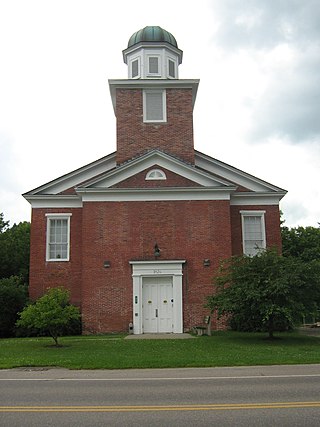
The Cambridge Meetinghouse, also known locally as the Old Brick Church is a historic meetinghouse at 85 Church Street in Jeffersonville, the main village of Cambridge, Vermont. Built in 1826 as a union church for several denominations, it began use as the local town hall in 1866, a use that continued to 1958. It was listed on the National Register of Historic Places in 1981. It presently houses the local post office.
The Holland Congregational Church is a historic church on Gore Road in Holland, Vermont. Built in 1844, it is a prominent local example of Greek Revival architecture, and is the town's only surviving 19th-century public building. It was listed on the National Register of Historic Places in 1986.
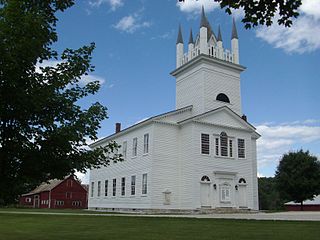
Sudbury Congregational Church, also known as the Sudbury Meetinghouse, is a historic church and town hall at 2702 Vermont Route 30 in Sudbury, Vermont. When it was built in 1807, it was a nearly exact replica of Plate 33 in Asher Benjamin's 1805 Country Builders Assistant. It was listed on the National Register of Historic Places in 1977.

The East Village Meetinghouse, also known as the Old Brick Church, is a historic church at 55 Vermont Route 14 in East Montpelier, Vermont. Built in 1833-34, it is a fine local example of Greek Revival architecture, and has been the focal point of the historic East Village for most of its history. It was listed on the National Register of Historic Places in 1980.

The Italian Baptist Church is a historic church at 10 North Brook Street in the city of Barre, Vermont. Built in 1906-08 largely with volunteer labor, it is a distinctive regionalized example of vernacular church architecture more typically found in northern Italy. It was listed on the National Register of Historic Places in 1975.
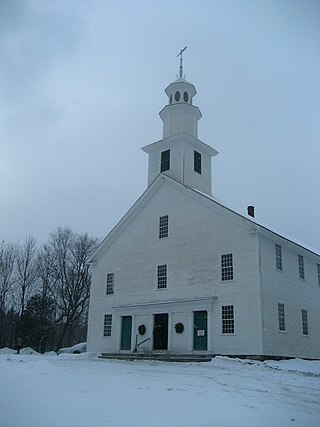
Old West Church is a historic church on Old West Road in the Kents Corner area of Calais, Vermont. Built 1823–25, it is a little-altered example of an early 19th-century rural Vermont church. It was added to the National Register of Historic Places in 1973.

The New Ipswich Town Hall is a historic academic and civic building on Main Street in the center village of New Ipswich, New Hampshire. The 1+1⁄2-story wood-frame structure was built in 1817 to serve the dual purpose of providing a town meeting place, and to provide space for a private academy. The building has been little altered since 1869, when it was substantially reconfigured solely for town use. The building was listed on the National Register of Historic Places in 1984.

The Asahel Kidder House, is an historic house at 1108 South Main Street in Fair Haven, Vermont. Built about 1843, by the efforts of a prosperous local farmer, it is a remarkably sophisticated expression of Greek Revival architecture for a rural setting. It was listed on the National Register of Historic Places in 1997.

Damon Hall, also known as Hartland Town Hall, is located at the junction of United States Route 5, Quechee Road, and Vermont Route 12 in the village center of Hartland, Vermont. Built in 1914-15 as a memorial to the locally prominent businessman William E. Damon, it is a fine local example of Colonial Revival architecture, and has served the town in many capacities since its construction. It was listed on the National Register of Historic Places in 1988.
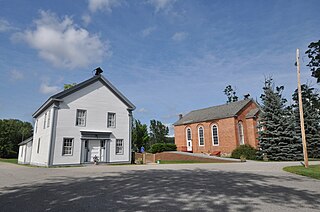
The School House and Town Hall is a historic municipal building on Schoolhouse Road, just west of United States Route 7 in the center of Leicester, Vermont. Built about 1858, it is a fine example of late Greek Revival architecture, and is the town's best-preserved district schoolhouse. Its upper floor has served as the town hall since its construction. It was listed on the National Register of Historic Places in 1988.

The Ripton Community House, formerly the Ripton Congregational Church, is a historic former church and present community hall on Vermont Route 125 in the village of Ripton, Vermont. Built in 1864 for a Congregationalist church, it has since served as a community clubhouse and town-owned meeting hall, and is a fine local example of vernacular Greek Revival architecture. It was listed on the National Register of Historic Places in 1973.
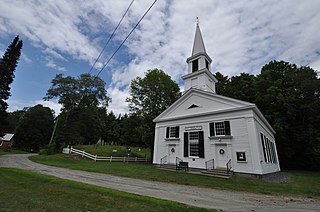
The West Fairlee Center Church is a historic church building at Middlebrook and Bear Notch Roads in West Fairlee, Vermont. Built in 1855, it is a fine and little-altered example of rural Greek Revival architecture, also notable for the association of its congregation with Nathaniel Niles, a prominent local minister, landowner, and politician. It was listed on the National Register of Historic Places in 2002.






















